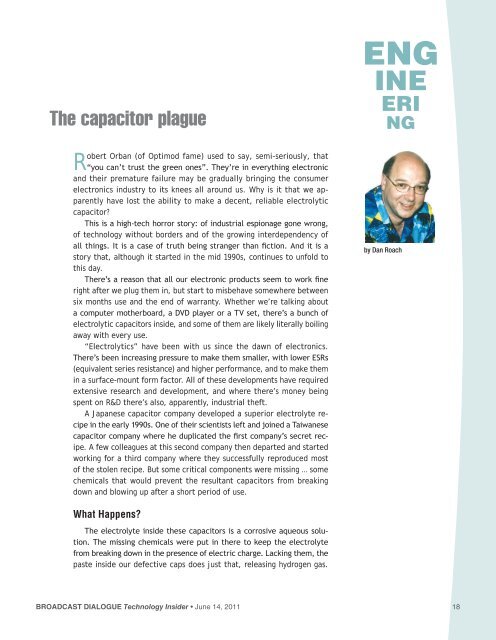Current PDF Edition - Broadcast Dialogue
Current PDF Edition - Broadcast Dialogue
Current PDF Edition - Broadcast Dialogue
You also want an ePaper? Increase the reach of your titles
YUMPU automatically turns print PDFs into web optimized ePapers that Google loves.
The capacitor plague<br />
Robert Orban (of Optimod fame) used to say, semi-seriously, that<br />
“you can’t trust the green ones”. They’re in everything electronic<br />
and their premature failure may be gradually bringing the consumer<br />
electronics industry to its knees all around us. Why is it that we apparently<br />
have lost the ability to make a decent, reliable electrolytic<br />
capacitor?<br />
This is a high-tech horror story: of industrial espionage gone wrong,<br />
of technology without borders and of the growing interdependency of<br />
all things. It is a case of truth being stranger than fiction. And it is a<br />
story that, although it started in the mid 1990s, continues to unfold to<br />
this day.<br />
There’s a reason that all our electronic products seem to work fine<br />
right after we plug them in, but start to misbehave somewhere between<br />
six months use and the end of warranty. Whether we’re talking about<br />
a computer motherboard, a DVD player or a TV set, there’s a bunch of<br />
electrolytic capacitors inside, and some of them are likely literally boiling<br />
away with every use.<br />
“Electrolytics” have been with us since the dawn of electronics.<br />
There’s been increasing pressure to make them smaller, with lower ESRs<br />
(equivalent series resistance) and higher performance, and to make them<br />
in a surface-mount form factor. All of these developments have required<br />
extensive research and development, and where there’s money being<br />
spent on R&D there’s also, apparently, industrial theft.<br />
A Japanese capacitor company developed a superior electrolyte recipe<br />
in the early 1990s. One of their scientists left and joined a Taiwanese<br />
capacitor company where he duplicated the first company’s secret recipe.<br />
A few colleagues at this second company then departed and started<br />
working for a third company where they successfully reproduced most<br />
of the stolen recipe. But some critical components were missing … some<br />
chemicals that would prevent the resultant capacitors from breaking<br />
down and blowing up after a short period of use.<br />
ENG<br />
INE<br />
ERI<br />
NG<br />
by Dan Roach<br />
What Happens?<br />
The electrolyte inside these capacitors is a corrosive aqueous solution.<br />
The missing chemicals were put in there to keep the electrolyte<br />
from breaking down in the presence of electric charge. Lacking them, the<br />
paste inside our defective caps does just that, releasing hydrogen gas.<br />
bRoADCASt DIALoGuE Technology Insider • June 14, 2011 18

















